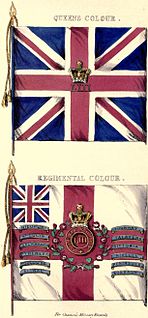
The King's Shropshire Light Infantry (KSLI) was a light infantry regiment of the British Army, formed in the Childers Reforms of 1881, but with antecedents dating back to 1755. It served in the Second Boer War, World War I and World War II. In 1968, the four regiments of the Light Infantry Brigade amalgamated to form The Light Infantry, with the 1st KSLI being redesignated as the 3rd Battalion of the new regiment.

The 53rd (Shropshire) Regiment of Foot was a British Army regiment, raised in 1755. Under the Childers Reforms it amalgamated with the 85th Regiment of Foot to form the King's Shropshire Light Infantry in 1881.
The 78th Regiment, (Highland) Regiment of Foot also known as the 78th Fraser Highlanders was a British infantry regiment of the line raised in Scotland in 1757, to fight in the Seven Years' War. The 78th Regiment was one of the first three Highland Regiments to fight in North America.
The 65th Regiment of Foot was an infantry regiment of the British Army, raised in 1756 as the 2nd Battalion, 12th Regiment of Foot. Under the Childers Reforms it amalgamated with the 84th Regiment of Foot to become the 1st Battalion, York and Lancaster Regiment in 1881.

The 71st Regiment of Foot was a Highland regiment in the British Army, raised in 1777. Under the Childers Reforms it amalgamated with the 74th (Highland) Regiment of Foot to become the 1st Battalion, Highland Light Infantry in 1881.
The 37th Regiment of Foot was a line infantry regiment of the British Army, raised in Ireland in February 1702. Under the Childers Reforms it amalgamated with the 67th Regiment of Foot to become the Hampshire Regiment in 1881.
The 61st Regiment of Foot was an infantry regiment of the British Army, raised in 1756. Under the Childers Reforms it amalgamated with the 28th Regiment of Foot to form the Gloucestershire Regiment in 1881.
The 109th (Aberdeenshire) Regiment of Foot was an infantry regiment of the British Army from 1794 to 1795. Raised by Alexander Leith Hay for service in the French Revolutionary Wars the regiment was briefly deployed in Jersey before it was disbanded in England and its men sent to reinforce the 53rd (Shropshire) Regiment of Foot. The disbandment was controversial as Leith-Hay believed it contravened an assurance given to him in his original letter of service to raise the regiment.
The 99th Regiment of Foot was an infantry regiment of the British Army, raised in 1780 by Charles Rainsforth and disbanded in 1783.
The 85th Regiment of Foot was a British Army line infantry regiment, raised in 1793. Under the Childers Reforms it amalgamated with the 53rd (Shropshire) Regiment of Foot to form the King's Shropshire Light Infantry in 1881.
General Francis Leighton was a general of the British Army.
The 91st Regiment of Foot had a brief existence as a British Army infantry regiment between 1759 and 1763. It was raised in Ireland, posted in turn to the West Indies and the Iberian Peninsula and finally disbanded in 1763. Some of the personnel then transferred to the 3rd Regiment of Foot, then stationed in Menorca. The Regimental Colonel throughout its life was Lt-Gen. Cadwallader Blayney, 9th Baron Blayney who had fought at the Battle of Minden in August 1759.
The 81st Regiment of Foot was an infantry regiment in the British Army from 1777 to 1783.
The 88th Regiment of Foot was an infantry regiment in the British Army from 1779 to 1783, formed to help protect the West Indies during the American Revolutionary War.
The 89th (Highland) Regiment of Foot or Morris's Highlanders was an infantry regiment in the British Army from 1759 to 1765.
The 89th Regiment of Foot was an infantry regiment in the British Army from 1779 to 1783.
The 90th Regiment of Foot was a line infantry regiment of the British Army during the American Revolutionary War.
The 90th Regiment of Foot was a short-lived infantry regiment in the British Army which was raised in Ireland as a light infantry corps in 1759, during the Seven Years' War with France.
The 85th Regiment of Foot was a short-lived British Army regiment during the Seven Years' War. It was recruited at Shrewsbury in 1759 as the first full regiment of light infantry in the British Army and originally intended for service in the North American campaign.


